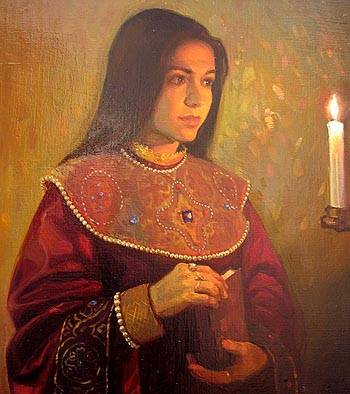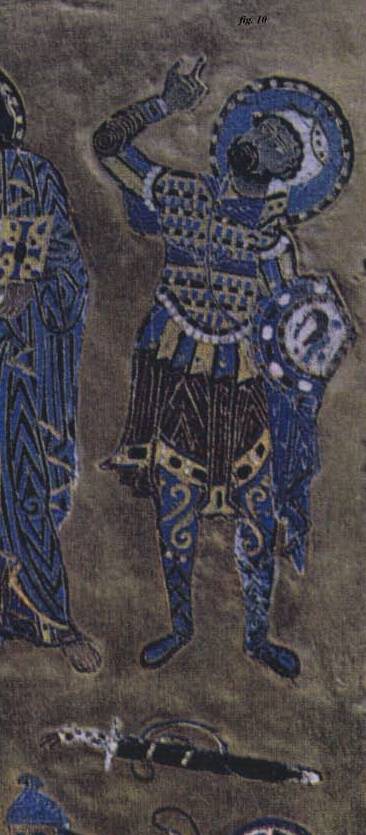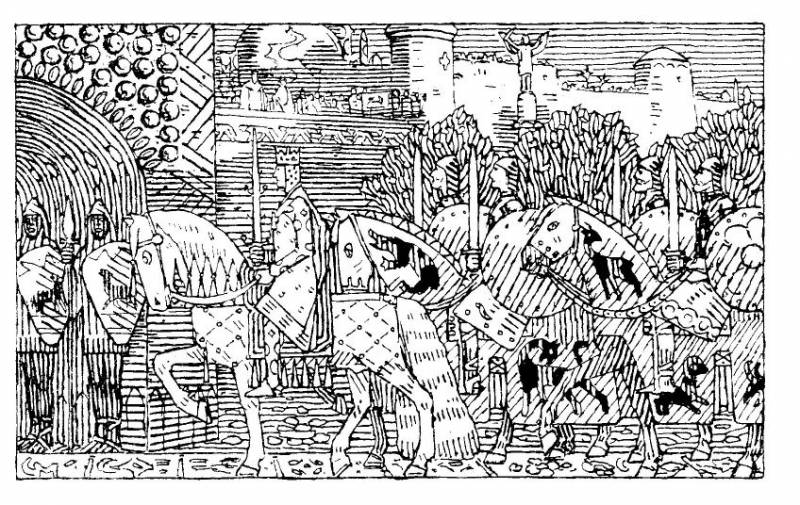Serving Empire Romeev. Part of 1
First, the leaders and the kings with their retinues joined the ranks of Varanga. It was not shameful - because the Byzantine monarch was the first among others. Notable mercenaries, foreigners, occupying command positions, in addition to pay and the due part of military production, received from the emperor and the rich gifts. Acquired invaluable combat experience, communications, huge material resources.
It was not for nothing that during the Constantinople visit of King Eric of Denmark to 1103, many of the King's accompanying him joined Varange. When, in 1108, the Norwegian King Sigurd I Magnusson returned home from Constantinople from a crusade, many of his compatriots arrived in the capital of Byzantium only to get to the imperial service. In 1153, Earl of Orkney headed the 15 ships on a crusade - and 6 of them separated from the detachment in Gibraltar: having arrived in Constantinople, the ship crew replenished Varanga.
Sigurd I Magnusson (1090 - 26. 03. 1130) is the Norwegian king in 1103 - 1130. Fig. - King Crusader Sigurd enters Constantinople
Since the Varangian Guard has become an integral part of the emperor’s security system (directly responsible for the personal security of the head of state), personal loyalty to the basilica by the leaders of the units arriving in Varangi should be considered a very significant circumstance. A system of personal loyalty, different from the Byzantine one (reminiscent of the relationship of the prince and his retainer) of the leaders of Varanga to its supreme leader, the basil, was reproduced.
Secondly, serving the empire as part of Varangi was considered an honor. Both for social and material reasons, this service was very attractive for representatives of European elites. Young people from Scandinavia and Russia regularly flocked under the banner of the Varangian Guard. To a large extent, this was facilitated by its high status in Byzantine society - the soldiers of Varangi enjoyed universal respect. Bolly Bollason, the famous guardsman Varangh, recalled in his saga of a gilded helmet that adorned his head, spear, red shield and that when the varangas were accommodated for the night, the women were ready to give anything for just to see brilliant guardsmen. Countless mentions in the Scandinavian sagas and runic inscriptions about people who served in Varang testify (given that these sources noted the most important events in the lives of the leaders and warriors) about the significance for the northerners of the fact that they belong to the Byzantine Varang.
Thirdly, starting from the XII - XIII centuries. service dynasties are formed, replenishing the Guard with representatives of northern peoples. A hereditary order of replenishment of Varanga is taking shape - when devotion to the monarch was absorbed, almost literally, “with mother's milk”. So, in 1453, the city of Constantinople was defended by the so-called. Varangopules (lit. - “children of the Varangians”) are descendants from the relations of the Varangians with the representatives of the local population. In Scandinavia (first of all, Norway and Sweden) and in Russia over the century (by the 80 years of the XI century) special social groups were formed, people from whom carried hereditary military service in Constantinople. The source noted the Vikings ("carrying swords on their shoulders") who consider loyalty to the emperors and their protection as a hereditary duty - the lot, which passes from father to son.
Fourth, individual adventurers, warriors who were not at work, pilgrims constantly replenished the ranks of Varangi. Moreover, these unique “soldiers of fortune” were almost the most reliable element of the Varangian Guard. Professional and domestic soldiers, disarmed in everyday and social terms, worked out bread and butter - faithfully serving the Byzantine Empire.
As noted, in 1118, after the death of Emperor Alexei I Comnenus, of all the old Guards units, only the Varangian Guard remained. Later, by the end of the 13th century, most of the guard units were transferred mainly to the performance of palace and ceremonial duties.
The book of posts of Pseudo-Codina (XIV century) says that the guardsmen moved in front of the emperor, and also drove the guard and guarded the procession. Varangi guarded the residence of the emperor and the imperial reception room in the Vlaherna Palace, were at the throne during official receptions (like the Russian Tsar’s bazaars), accompanied the monarch when visiting the temple. Varangians always accompanied the horse emperor. Thus, the guard performs the tasks of the imperial convoy. The Varangian Guard is mentioned in the sources in 1328, 1330, 1341, 1404 and 1422.
It is believed that further protection of the imperial palace was entrusted to the Cretan Guard (famous in the battles of Constantinople 1453), while Varanga switched to the protection of the imperial treasury. Due to organizational and economic difficulties, the number of units gradually decreases. In this period, hereditary succession was finally formed when manning the Guardians.
Etherius was commanded by the Great Etheriarch, who was appointed by the emperor. Depending on the situation, the Great Etheriarch could also command army units in the theater of operations.
The names of some of them have come down to us. Thus, the Great Etheriarch Feoktist in the 1030s acted in Syria. At the head of the Varangian Guard, he distinguished himself in August 1030 in the battle of Halep (Aleppo). After returning to the capital, he was again sent to Syria - at the head of a significant contingent, which included not only Varanga, but also Byzantine units. In 1033, Emperor Roman III Argir again sent Feoktista to Syria - and again with great strength.
In 1047, the Great Etheriarch Konstantin commanded the entire Eastern Army, which besieged Helidonius — a fortress in Armenia (not far from Dvina).
Anna Comnina [(01. 12. 1083 - 1153) - the Byzantine princess, the eldest daughter of Alexei I Komnin and one of the first female historians. I became a historiographer of my father - having written "Alexiada" - historical a story about the era of Alexy Komnin. "Alexiada" - one of the most famous sources on the Byzantine history of the era of the Crusades] mentions the Great Etheriarch of his father, Argir Karats, who, "despite the Scythian origin," was a very prudent man and was a servant of truth and virtue.

Anna Komnina. Picture. Hood Sokolovskaya
We also know the Great Etheriarch Konstantin Triepsy, who faithfully served Emperor Andronicus I Comnenus in the 1183-1185 years.
Like any guard, Varanga was a forge of personnel — not only for the Romanes, but also for foreign armies. Serving in it was honored for the representatives of the ruling houses of Europe - and after returning home, they occupied responsible positions in the military and administrative hierarchies of their states. The most vivid example is the future King of Norway and the seeker of the English throne, Harald Hardrada. As an officer of the Varangian Guard in his youth, he fought in Bulgaria, Sicily, Syria and Mesopotamia - participating in field battles and in the sieges of fortresses and cities. It was a very good school of life, hardening him for life.
Often, such commanders led the units of Varangi in 500 Warriors (Hardrada commanded such a unit in 1040 in Thessalonica). Such middle-level commanders were called spafarokandidami. The term “Spafarok” is derived from spatharios and kandidatos - both of which designated the soldiers of the palace guard in the 4th - 6th centuries. The earliest mention of the Spafarokidin rank is the beginning of the 8th century, and the first known attestations are the beginning of the 9th century. The distinguishing mark of the spafarok candidate's rank is maniakion (a golden chain worn on the chest).
The best guardsmen and junior commanders were assigned the rank of Manglabit. The term (from μαγγλάβιον, i.e. “cudgel”) appeared in the 9th century. and designated persons who were responsible for the security of the person of the emperor. Armed with batons (manglavion) and swords, the manglabies moved in front of the emperor during ceremonies, were responsible for the functioning and security of the gates of the imperial palace. The rank of Manglabita became significant in the hierarchy due to the proximity of its carrier to the emperor. He disappears at the end of the XI century. The distinguishing mark of the rank was a sword with a golden hilt.

Image of a Roman officer - Centurion Longin. Byzantine mosaic of Nea Moni, Chios, XI century. In reality, the Varangian officer is depicted. Attention is drawn to the emblem on the shield (on the emblematics of Varangi - below) and the hood. The officer is dressed in a red tunic with golden embroidery passing below, a raincoat of dark blue with gold and red trim, pants of a dark blue color decorated with gold arrowheads. The dark blue shield is decorated with stones at the edges, the central field of the shield is edged with white pearls. The emblem of the Varangian Guard (raven) - half blue - half black; points around the crow 4 - supposedly rivets for attaching the belt
The system itself is interesting in which the best of the military officers were enrolled in the retinue of the monarch and the palace guard (perhaps an echo of the ranks of the ranks of the Russian Empire can be considered an echo).
There was also a post of Akolufa. Akolouf - the head of the Life Guards, i.e., a unit of Varanga, which was directly under the emperor. Initially, this title was assigned to the commander of the mercenary army, and later to the commander of the Russian-Varangian corps. Administratively, Akolouf was associated with another supreme military rank of the empire, commanding the palace guard - Drungary Vigla. From time to time, the Akoluphs received command of all foreign forces in the imperial service, and sometimes over all Byzantine troops.

Akoluf
Later on, at the palace stage of the history of the Varangian Guard, Akoluf commanded the Varangas, while the Great Etheriarch headed all foreign units in the imperial service. In the work of Pseudo-Codina [Byzantine anonymous author of the XIV century.] It is directly stated that Akolouf was in charge of the warangs and was accompanied by basileus.
Akoluf - one of the highest ranks of the officer of the Byzantine Empire. For example, during the absence of the emperor, it was Akoluf who was the keeper of the keys to the gates of Constantinople.
Many imperial Akoluphs distinguished themselves during the fighting on the countless fronts of Byzantium. For example, in 1034, the city of Akoluf commanded the army that had suppressed the uprising of Adam of Sebaste. One of the most famous Akolufov was Michael. He is mentioned in the writings of I. Skilitsa [John Skilitsa - in 1081 - 1118's. Alexey Komnin's dignitary, chronicler. The central work - "Review of History"] and K. Kekavemena. Michael distinguished himself in the Byzantine-Pechenezh war of 1050-53. The emperor sent Michael, the "hegemon of the whole army," to counter the raids of the Pecheneg hordes. Having received the order not to get involved in a decisive battle, Mikhail acted successfully, smashing the Pechenegs in parts. Then Michael was sent to Iviria - to fight against the Turks, and then commanded the Varangians and the Franks stationed in Iviria and Haldia. Commanding the Varangian-Frankish contingent, Mikhail in 1054 in the Armenian theater of war defeated the army of the Sultan of the Seljuk Turks Togrul-bek. The merits of Michael were duly appreciated by the state - at the same time he was honored with several more senior positions: the imperial patrician and the archon (stratig) of the Parastrion theme. The rank of patrician meant enrollment in the category of the highest nobility of the empire, and Sttig as the governor of the topic and the commander-in-chief of the army of fems had in his hands the full civil and military power. In the imperial table of ranks, the stratigas belonged to the ranks of the first class.
To get to the service in the Varangian Guard was not easy. But, as the sagas noted, Scandinavian origin is half the battle. The candidate for the guards paid an entrance fee (Varangas could help a countryman), and there were government loans. It is known that the fighters of Varanga were put on special lists - besides the name the warrior’s salary and the incentive measures applied to it were indicated.
The fighters of Varangi received high pay - in the month of 10 - 15 nomisme (45 - 60 grams of gold), which in 1,5-2 times the salary of soldiers of other elite units, and in 7-10 times there were more army salaries. In addition, there were different allowances and the share of military production. For example, after the victory over Bulgaria Vasily II, all military booty was divided into 3 units - and Varang received a third. Imperial gifts (for example, at the coronation) and gifts (for example, for Easter) were a great help for the Varangians. Daily soldiers received rations.
The state took care of the housing conditions of the guards. Thus, the imperial guards were allotted to entire neighborhoods near the hippodrome - in the complex of the Grand Palace. One prisoner (in the barracks there was a prison of his own) complained about the noise and smoke produced by the Varangians at night, more unpleasant, “than in the kingdom of Aida” [Guilland R. Études de topographie de Constantinople byzantine. Tome I. Berlin, 1969. S. 41] - which came from the bottom, from the Numera barracks (another Guards unit). When Basil Leo VI visited the premises of the Varangians, he noted the rooms of the guardsmen painted with shields. [Liutprand. Antapodosis. 1930. T. 1. S. 12].
The combat activities and livelihoods of Varangi provided a significant number of servants and pack animals - and servants could accompany the soldiers in the campaigns. In economic terms, parts of Tagmata were on the provision of the Optimate theme (empire theme in the western part of Asia Minor).
During the fighting, the Varangas had the advantage of looting the enemy city. There was also an interesting custom: after the death of the emperor, the varangas had the right to enter the palace and take what they liked. Harald Hardrada was rich not least because in this way he visited the imperial treasuries three times. If we add to this, the broad prospects for personal enrichment (capture of trophies and mining from participation (mostly successful) in hostilities, signs of encouragement and attention from the emperor and other persons), then the words of the saga are clear that up to Harald in northern Europe it has not yet been seen that one man owned so many treasures.
Of course, Harald is an outstanding model, but the consequences of the service and ordinary warangs exceeded their wildest expectations. The Anglo-Varangians were also given land plots. Such a measure of the government of Alexei Comnenus was especially important in relation to the exiles deprived of their homeland and property - after all, the Anglo-Saxons could not serve in the Guard and return, as the Scandinavians and the Russ “home” could not be, and Byzantium became their homeland.
To be continued

Information